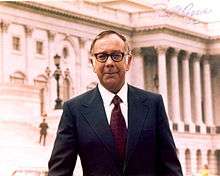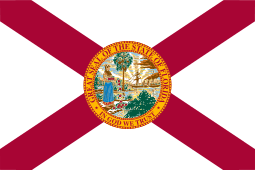Paul Rogers (politician)
| Paul Rogers | |
|---|---|
 | |
| Member of the U.S. House of Representatives from Florida's 11th district | |
|
In office January 3, 1973 – January 3, 1979 | |
| Preceded by | Claude Pepper |
| Succeeded by | Daniel A. Mica |
| Member of the U.S. House of Representatives from Florida's 9th district | |
|
In office January 3, 1967 – January 3, 1973 | |
| Preceded by | Don Fuqua |
| Succeeded by | Louis Frey, Jr. |
| Member of the U.S. House of Representatives from Florida's 6th district | |
|
In office January 3, 1955 – January 3, 1967 | |
| Preceded by | Dwight L. Rogers |
| Succeeded by | Sam M. Gibbons |
| Personal details | |
| Born |
June 4, 1921 Ocilla, Georgia |
| Died |
October 13, 2008 (aged 87) Washington D.C. |
| Political party | Democratic |
| Spouse(s) | Rebecca Bell |
| Alma mater | University of Florida College of Law |
| Profession | Law |
| Religion | Methodist |
Paul Grant Rogers (June 4, 1921 – October 13, 2008) was an American lawyer and politician from the U.S. state of Florida. A Democrat, Rogers served in the U.S. House of Representatives as the member from Florida's 11th congressional district. He was chairman of Research America from 1996 to 2005.[1]
Biography
Early life
Rogers was born in Ocilla, Georgia, on June 4, 1921. He attended the University of Florida, where he was President of Florida Blue Key and graduated with a Bachelor of Arts degree in 1942. After graduating he joined the U.S. Army, serving in World War II from 1942 to 1946 during which he rose to the rank of Major and received a Bronze Star Medal.[1] Rogers attended The George Washington University Law School but did not graduate there, receiving his law degree instead at the University of Florida College of Law in 1948. Rogers worked as a lawyer in private practice and was a member of the board of directors for Merck & Co. and Mutual Life Insurance Co. of New York.
Political career
He was elected as a Democrat to the 84th Congress in a special election to fill the vacancy caused by the death of his father, Dwight L. Rogers. Rogers served for and was reelected to the eleven succeeding congresses, for 24 years from January 4, 1955, to January 3, 1979. He chose not to run for reelection to the 96th Congress. While a member of the House, Rogers served as chair of the Subcommittee on Health and the Environment from 1971 to 1979. Nicknamed "Mr. Health," he was a key representative behind the adoption of the National Cancer Act of 1971, the Medical Device Amendments of 1976, the Health Maintenance Organization Act, the Emergency Medical Service Act, the Medicare-Medicaid Anti-Fraud and Abuse Amendments of 1977 and the Clean Air Act of 1970.
Rogers was a resident of West Palm Beach, Florida and a partner in the Washington, D.C. office of Hogan & Hartson. He was also active in the National Osteoporosis Foundation, Friends of the National Library of Medicine, and the National Leadership Coalition on Health Care (now the National Coalition on Health Care).
Mark Foley has said that a meeting with Rogers when Foley was three years old inspired him to go into politics.[2] After suffering from lung cancer and undergoing an operation, Rogers died of the disease in Washington D.C. on October 13, 2008, at a rehabilitation hospital.[3]
Awards and honors
- Public Welfare Medal from the National Academy of Sciences (1982).[4]
- National Health Lawyers Association Health Policy Award (1991)
- Albert Lasker Public Service Award (1993)
- American Pharmaceutical Association Hugo H, Schaefer Award (1994)
- AlliedSignal Achievement Award in Aging (1994)
- Distinguished Leadership Award from the University of Florida Health Sciences Center (1994)
- National Osteoporosis Foundation Leadership Award (1995)
- Maxwell Finland Award for Scientific Achievement (1996)
- National Cancer Institute "Year 2000" Award
- Edwin C. Whitehead Award for Medical Research Advocacy from Research!America. (2005)[5]
In June 2001, by an act of Congress, the main plaza at the National Institutes of Health was named in his honor.[6] Recently, Research!America established the Paul G. Rogers Society for Global Health Research, which honors Rogers' dedication to the health care policy and advocacy.[7]
References
- 1 2 Hevesi, Dennis (October 15, 2008). "Paul G. Rogers, ‘Mr. Health’ in Congress, Is Dead at 87". The New York Times.
- ↑ http://staugustine.com/stories/081303/new_1730608.shtml
- ↑ "Longtime Fla. congressman Paul G. Rogers dies", Associated Press, October 13, 2008. Archived October 28, 2008, at the Wayback Machine.
- ↑ "Public Welfare Award". National Academy of Sciences. Retrieved 18 February 2011.
- ↑ http://www.researchamerica.org/media/bios/rogers.html
- ↑ http://www.researchamerica.org/about/paul.rogers.plaza.tribute.pdf
- ↑ http://www.researchamerica.org/pgrsociety/index.html
External links
- Rogers's Biographical Directory of the United States Congress entry
- Friends of the National Library of Medicine where Paul G. Rogers is Chairman of the Board of Directors
| United States House of Representatives | ||
|---|---|---|
| Preceded by Dwight L. Rogers |
Member of the U.S. House of Representatives from Florida's 6th congressional district 1955–1967 |
Succeeded by Sam M. Gibbons |
| Preceded by Don Fuqua |
Member of the U.S. House of Representatives from Florida's 9th congressional district 1967–1973 |
Succeeded by Louis Frey, Jr. |
| Preceded by Claude Pepper |
Member of the U.S. House of Representatives from Florida's 11th congressional district 1973–1979 |
Succeeded by Daniel A. Mica |

